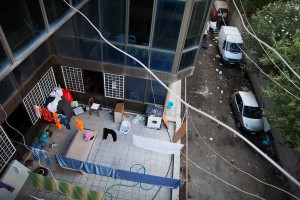Abbandonati a se stessi. Gli immigrati richiedenti asilo. Ecco cosa scrive il New York Times oggi occupandosi di Roma. Chissà se il ministro ad hoc Andrea Riccardi l’ha visto. Forse è troppo occupato a formare liste per Mario Monti, tra un incontro con Montezemolo e l’altro con Casini. Chissà se a Sant’Egidio – bontà sua, Riccardi dice che non è coinvolta nell’operazione MNointi – hanno letto questo articolo. New York Times: il paradosso italiano sui rifugiati
Roma – Ufficialmente sono “protetti” dallo Stato, in realtà sono abbandonati a loro stessi, spesso in condizioni disumane. È “il paradosso italiano sui rifugiati” descritto oggi da Elisabetta Povoledo del New York Times.
Una lunga corrispondenza descrive la vita di ottocento rifugiati africani ammassati nel Salaam Palace, un edificio abbandonato alla periferia sud di Roma. Un esempio del “fallimento dell’Italia nell’assistere e integrare le persone alle quali ha riconosciuto l’ asilo in base alle sue leggi”.
L’Italia e’ piuttosto brava nelle procedure di richiesta di asilo, riconoscendo il 40 per cento delle domande, anche fino al 50 per cento in alcuni anni, quello che non funziona e’ quanto avviene dopo”, dice al New York Times Laura Boldrini, portavoce dell’Unhcr in Italia. Il nostro Paese riesce a garantire assistenza a poco più di tremila persone, “se non hai la fortuna di essere una di queste – denuncia Boldrini – sei solo. Devi trovare come sopravvivere, imparare la lingua, trovare una casa o un lavoro”.
L’assistenza ai rifugiati, sottolinea il New York Times, non è tra le priorità del governo in tempi di crisi economica, mentre gli italiani sono assorbiti dai loro problemi. “Certo sarebbe uno sforzo finanziario, ma servirebbe a trasformare i rifugiati in cittadini che pagano le tasse, quindi sarebbe un investimento utile” nota Christopher Hein, direttore del Consiglio Italiano per i Rifugiati.
Intanto, al Salaam Palace, la vita è sempre più difficile. E Yakub Abdelnabi, un rifugiato sudanese che ha lasciato il suo paese nel 2005, commenta amaro: “Siamo scappati da una guerra per trovarne un’altra, ottocento persone accalcate in un palazzo”.
Ecco l’articolo del NYT del 27.12.12:
In Italy, Shantytowns of Refugees Reflect Paradox on Asylum
By ELISABETTA POVOLEDO
Published: December 26, 2012
ROME — The abandoned university building on the outskirts of Rome, colloquially known as Salaam Palace, was once a sparsely populated makeshift shelter where new arrivals from Africa — fleeing war, persecution and economic turmoil — squatted to create their own refuge.
Over the years, scattered mattresses were joined by sloppily plastered plywood walls, slapdash doors and scavenged furniture. Today, an irregular warren of tiny rooms includes a small restaurant and a common room. On a recent cold afternoon, a hammer clinked as a bathroom was added to a one-room apartment where an oven door had been left open for heat.
More than 800 refugees now inhabit Salaam Palace, and its dilapidation and seeming permanence have become a vivid reminder of what its residents and others say is Italy’s failure to assist and integrate those who have qualified for asylum under its laws.
Salaam Palace and an expanding population in shantytowns elsewhere are the result of what refugee agencies say is an Italian paradox surrounding asylum seekers.
“Italy is quite good when in the asylum procedure, recognizing 40 percent, even up to 50 percent of applicants in some years,” said Laura Boldrini, the spokeswoman for the United Nations High Commissioner for Refugees in Italy. “What is critical is what comes after.”
She and others involved in aiding refugees say that neglect and absence of resources add unnecessary hardship to already tattered lives and are creating a potential tinderbox for social unrest.
Italy has just 3,150 or so spots in its state-financed asylum protection system, in which refugees receive government assistance. Waiting lists are impossibly long, leaving many to fend for themselves.
“If you’re not lucky to get one of those, you’re on your own. You have to find a way to support yourself, learn the language, get a house and a job,” Ms. Boldrini said.
That has certainly been the experience of those in Salaam Palace. Some have been living in the building since early 2006, when it was occupied by a group of refugees with the help of an organized squatters’ association.
Most had fled war and other hardships in Sudan and the Horn of Africa. Nearly all have refugee status, or some form of protection, but they have been unable to find steady work in Rome. Italy’s economic crisis has made that challenge all the harder.
“We escaped one war to find another kind of war — 800 people crammed in a palazzo,” said Yakub Abdelnabi, a resident of Salaam Palace who left Sudan in 2005.
Last summer, Nils Muiznieks, the Council of Europe commissioner for human rights, visited Salaam Palace, and according to a council report issued in September, “witnessed the shocking conditions in which the men, women and children were living in this building, such as one shower and one toilet shared by 250 persons.”
Apart from volunteers, the residents had no guidance to help them find work, go to school or deal with administrative burdens, the report said. “This has effectively relegated these refugees or other beneficiaries of international protection to the margins of society.”
Local authorities can demand documents for social assistance, documents that are often impossible for the refugees to obtain. Occasional government-financed aid projects have had negligible effect, residents said.
Though immigrants are granted access to medical care, many are leery of navigating Italy’s labyrinthine national health system, which is why on a blustery December day, medical students had volunteered to provide flu shots to some residents of Salaam Palace, in a makeshift clinic amid cigarette butts and empty beer bottles.
“This is the worst time of the year, when the risk of epidemic is high,” said Dr. Donatella D’Angelo, the president of a volunteer association that provides weekly health care at Salaam Palace.
In recent weeks, she and her team of volunteers have provided more than 100 flu shots to residents. “It’s a drop in the bucket,” she said. “Look at the conditions they live in and tell me if they’re not likely to transmit the flu to each other.”
Those with health complaints are referred to state hospitals and clinics, but the doctors can do little about the psychological frailty that overcomes many.
“Depression, in various forms, is normal here,” said Dr. Marta Mazza, a volunteer.
Because of its geography, Italy is more exposed to migration from Africa, and it has called on other European Union countries to help bear the burden. Even so, the country has lagged in its own response, refugee agencies say.
“It has never invested in a system that’s structural,” said Ms. Boldrini, of the United Nations High Commissioner for Refugees. “Every year is treated as if it’s any emergency.”
Under European Union rules, asylum seekers must stay in the country in which they entered Europe, and can be sent back if they go elsewhere. Many residents of Salaam Palace say they sought something better, in France, Britain or Germany, but found themselves back in Rome.
“No one believes that we can live like this in Italy,” said Bahar Deen Abdal, 28, a nattily dressed Sudanese man who has lived in Salaam Palace for four years. “This place, it’s like being in jail.”
Another 900 refugees in Rome live in equally, if not more, squalid conditions, according to a recent report, with one group occupying a shantytown along the Tiber.
As far as priorities go, assistance to the refugees ranks low on the government’s list of priorities when Italians are absorbed in their own economic struggles. Yet refugee agencies argue that Italy has every incentive to assist asylum seekers.
“Of course it means a financial effort,” said Christopher Hein, director of the Italian Refugee Council.” But refugees could be transformed into taxpaying citizens, Mr. Hein said. “We think the investment is worth it.”
Those at Salaam Palace try to make do. There is a canteen, run by residents, where basic needs, including injera, the Ethiopian and Eritrean bread, as well as some tomato sauce and spaghetti, can be found.
Yohannes Bereket, 35, was granted refugee status three years ago after fleeing his native Eritrea, where he had apprenticed as a shoemaker. Residents of Salaam Palace can hardly afford bespoke shoes. So today he ekes out a living mending clothes and cobbling the occasional sole.
“At least I have a place to sleep,” he said. “It’s not great, but I do what I can.”


